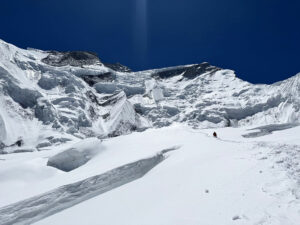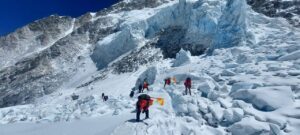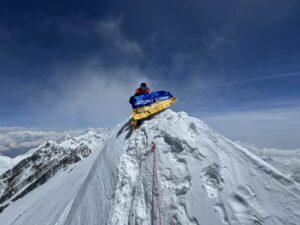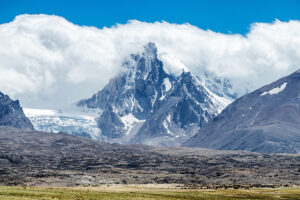Mingma Gyabu Sherpa, better known as Mingma David, is the youngest 14×8,000m summiter. He is also a business partner in Elite Expeditions.
Close followers of this world associate him most often with Nirmal Purja. But while Purja is the front man, Mingma David is the organizing mind behind all the expedition logistics. He is also a strong, reliable climbing partner.
Few remember that when the two men met for the first time in 2016, Mingma David was quickly building a remarkable high-altitude resumé while Purja was a total rookie. After climbing some lesser peaks, they went together to Everest in 2018, and Purja’s Project Possible quest was born.
Mingma David was there on the summit during nine of Purja’s 8,000’ers. And he was the logistics impresario who managed to put together the successful Winter K2 expedition in record time.

Mingma “David” Gyabu Sherpa with his Guinness certificate as the youngest 14×8,000m summiter. Photo: Mingma David
Last week, Mingma David spoke with correspondent Nabraj Ghimire about his latest expeditions. In particular, he shared his memories of Winter K2. His insight gives a clearer picture of that historic climb.
Mingma David started by describing his role in the Winter K2 venture.
“I was mostly busy arranging the logistics for the expedition,” he said. “[This meant] selecting the team members, coordinating staff, and implementing the ideas of our team leader, Nirmal Purja.”
Too busy organizing to train
While most of the Sherpas in Purja’s team had a chance to train on Island Peak before leaving for Pakistan, Mingma David could not join. He was too busy planning.
“Winter K2 was not a long-planned thing for us,” he said. “Everything came together so fast.”
Nirmal Purja landed in Pakistan accompanied by five Sherpa climbers. The effort to coordinate a joint effort by 10 Nepalis from different teams was not harmonious at first.
“As soon as our group reached K2 Base Camp, the first thing I did was go to talk with Mingma G from Imagine Nepal about how we could cooperate,” Mingma David said. “My first attempt failed because we were in tough competition.”
Eventually, they agreed to combine forces.
“The meeting of Mingma G and Nirmal Purja up at 7,000m was a positive step,” he said. “It was December 30, 2020. Mingma G’s team was already near Camp 3 and they were short of ropes. Mingma Tenzi from our group delivered the first ropes.”
The brotherhood of the rope
The ropes took on more than practical importance. “They were also a symbol of brotherhood,” Mingma David said. “We were three separate teams, united to reach a common goal.”

Mingma David on the summit of K2, January 16, 2021. Photo: Mingma G
Nabraj Ghimire asked Mingma David to recall the summit day:
That day, we cut off all radio communication with Base Camp. Our policy was to make zero contact so that no individual members could give information on their own…Base Camp had no updates on how we were doing or where we were on the mountain. We just focused on summit. Our plan was to relay news of the success through a proper channel. We finally reached the top, but only later we [released the news] through our UK PR Team.
Mingma David is proud of the achievement and how the Nepali anthem that they sang on top went viral. And yet he never foresaw the attention that their feat garnered around the world.
The same level of attention as Tenzing Norgay after Everest
“After K2, we were all planning to go directly to Thailand so we could enjoy some days on the beach in warm weather,” he said. But so many supporters wanted to see them back in Nepal that they scrapped their vacation.
“We flew home after happy times with Pakistani friends and government authorities,” said Mingma David. “It felt like the same level of public attention that Tenzing Norgay and Ed Hillary had after their Everest summit.”

Frame of the viral K2 summit video shared on social media on January 24.
Two days after they announced their successful summit, Nirmal Purja posted a surprising note on social media, claiming that he had used no supplementary oxygen on the ascent.
“This was planned in advance,” said Mingma David. “Either he or I [would] do this. If neither of us, then someone else in the group.”
Nirmal Purja tapped to go No-O2
Later, they decided on Purja. They wanted to do both the first summit and the first No-O2 summit. “In the mountaineering community,” Mingma David explained, “climbing with oxygen is sometimes taken lightly. We wanted to prove to the world that we could do it without oxygen as well.
“Nirmal Purja climbed without oxygen and that may be why he had some frostbite on his hand.”
But why the silence for two days between the summit and the no-O2 announcement?
“Our plan was to announce this news about [the No-O2] summit later, in the movie about K2 [which is currently in production],” he said. “But after we had too many controversial comments, we informed the world a few days later.”

Mingma David at a lower-than-usual altitude. Photo: Mingma David
Later, there was a quite heated discussion about whether the Nepali climbers concealed information or kept quiet about their decision to launch a summit push in order to top out first. Several Western and Pakistani climbers were also aiming for this “last winter prize of the 8,000’ers.”
A question of high-altitude endurance
Mingma G, one of the summiters and leader of the Imagine Nepal team, openly admitted that there was a competition and the Nepali climbers wanted to summit before anyone else. According to Mingma David, it was also a question of high-altitude endurance.

Mingma David on Winter K2. Photo: Mingma David
“Foreigners had already climbed the other 13 8000’ers, so we wanted this record for Nepal, to be honest,” he said. “We wished other foreigners were with us and had the chance to summit together, but it would not have been easy for them. As you know, we Sherpas are born and raised at high elevation. Genetically, how we approach the mountains is different. Just being a Nepali group gave us more freedom and confidence.”
WITH RESEARCH BY NABRAJ GHIMIRE






